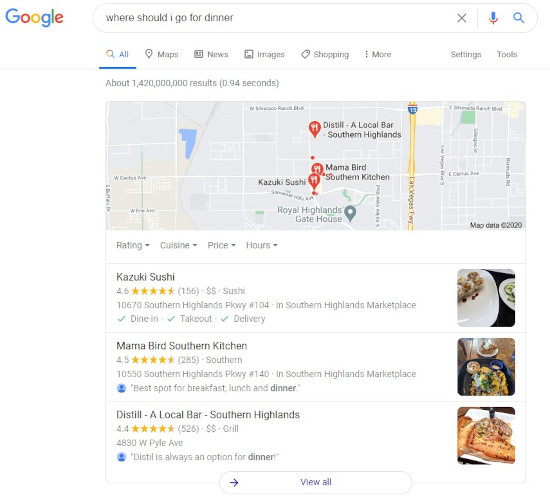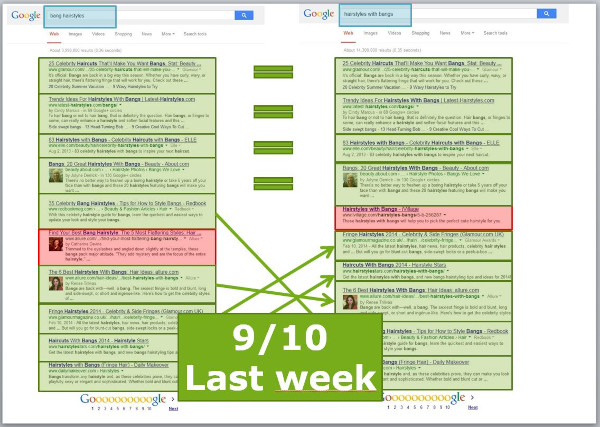Not long ago, if you wanted to find a place to eat, you needed to search for a term like “Boston restaurants”. But, today, you can instantly find a good restaurant that’s nearby if you just search for the term, “Where should I go for dinner?”
That’s because Google is sophisticated enough to recognize your intent or the implications of your query. However, prior to 2015, you needed to type the most straightforward queries into the search engine to find the answers you were looking for.
So how did Google evolve to understand their searchers’ intent and implications so quickly? Well on October 26, 2015, they confirmed that they updated their algorithm with a machine-learning artificial intelligence system called RankBrain.
In other words, RankBrain helps Google understand a searcher’s intent and serve the most relevant content to them.
How Does Google's RankBrain Work?
As explained above, RankBrain was designed for the searcher's experience in mind, particularly when it comes to understanding the intent and relationships behind seemingly complex searches.
In order to better explain this functionality, we break down how RankBrain works in conjunction with Google's algorithm as a whole:
RankBrain and Other Ranking Signals
Before RankBrain, Google used a number of ranking signals to determine:
- Relevance to the searcher's query
- The authority of a particular website and page to provide a trustworthy answer
- User experience so that the searcher would have their needs met in an enjoyable way and without friction
Some of these signals (or ranking factors) include:
- Crawlability/indexability
- Quality content
- Backlinks
- Page speed
- Mobile experience
While these ranking factors are still relevant, they don't tell the whole story anymore. For one, they are largely static and don't factor in semantic search, and that's where RankBrain differs from these components of Google's algorithm.
RankBrain and Machine Learning
Machine learning is a form of artificial intelligence that "learns" from data and improves based on experience. The advantage of machine learning is that it can analyze and connect multitudes of variables to "understand" beyond what a human analyst would be able to — if it has a sufficient amount of data.
Why is this relevant in the context of RankBrain? Because RankBrain is an example of machine learning as implemented by Google.
To accurately determine a searcher’s intent, Google feeds RankBrain a massive amount of data. Then, RankBrain analyzes it and teaches itself how to serve the most relevant results based off certain search signals, such as search history, device, and location.

For example, if you type the query “Where should I go for dinner?” into Google, the search engine will first pinpoint your location and detect the device you’re using. Then, it’ll use these factors to interpret your query’s intent, which Google will translate to “Which restaurants are currently open for dinner within walking distance of my current location?”, helping it serve the most relevant results to you.
RankBrain and Hummingbird
Hummingbird is a version of Google's search algorithm that extracts the meaning of the whole query rather than particular words. This component is the reason why Google can determine semantic meanings from specific queries to produce the best result.
RankBrain feeds user signals into this aspect of the algorithm, enhancing Google's ability to infer meaning. To be more specific about the relationship between the two, Connectica makes the following analogy that: "RankBrain is the thinking and Hummingbird is the memory."
An example of RankBrain's capabilities in this way is how similar the search results are for semantically similar but different keywords. For example, "bang hairstyles" and "hairstyles with bangs" have similar results, including keywords that are not optimized word-for-word for the specific query.

How Do You Optimize for RankBrain?
Even though RankBrain helps Google adapt to changing search behavior, most marketers still haven’t adapted their SEO strategy to this transformation. Here are some mindset changes you should adopt when thinking about modern-day SEO.
1. Stop thinking of SEO in terms of keywords alone.
"One of the main reasons we keep drilling our audience with the idea of topics over keywords is that search has evolved but our customer's content marketing strategies are lagging behind,” says Victor Pan, HubSpot’s Head of Technical SEO. “Practices like purposely creating pages with misspellings and poor grammar just because there is search volume need to go."
Today, people rely heavily on Google to provide accurate and relevant answers for most of their questions, so the search engine needs to understand the intent and context behind every single search.
To do this, Google has evolved to recognize topical connections across users’ queries, look back at similar queries that users have searched for in the past, and surface the content that best answers them. As a result, Google will deliver content that they deem the most authoritative on the topic.
2. Implement the pillar-cluster model.
To help Google recognize your brand as a trusted authority, consider implementing the pillar-cluster model on your blog. Using this strategy, you’ll create a single pillar page that provides a high-level overview of a topic and hyperlinks to cluster pages that delve into the topic’s subtopics. This signals to Google that your pillar page is an authority on the topic.
Hyperlinking all of the cluster pages to the pillar page also spreads domain authority across the cluster, so your cluster pages get an organic boost if your pillar page ranks higher, and your cluster pages can even help your pillar page rank higher if they start ranking for the specific keyword they’re targeting.
3. Move toward long-form, high-quality pages and posts.
On the editorial side of things, RankBrain has pressured content marketers to scrap a tactic that they should’ve abandoned years ago -- prioritizing volume over quality. Nowadays, spending more time and effort crafting insightful and compelling content at a lower volume is one of the best ways to bolster your standing with Google.
"If you have a huge inventory of 2000-era SEO tactics, I'd highly recommend consolidating the pages that are driving zero value to your business with 301 redirects,” says Pan. “It's not that less is more, but better is more. It's very common for a strong piece of content to rank for over hundreds of long-tail keywords of the same intent.”
RankBrain has advanced Google’s search engine to the point where people can interact with it like they're chatting with their friends -- and it’s time for content marketers to catch up.
If you apply the lessons learned above to your SEO strategy, however, you could adapt faster to RankBrain than Google’s search algorithm evolved after they implemented the AI system.
Editor's note: This post was originally published in April 2019 and has been updated for comprehensiveness.
